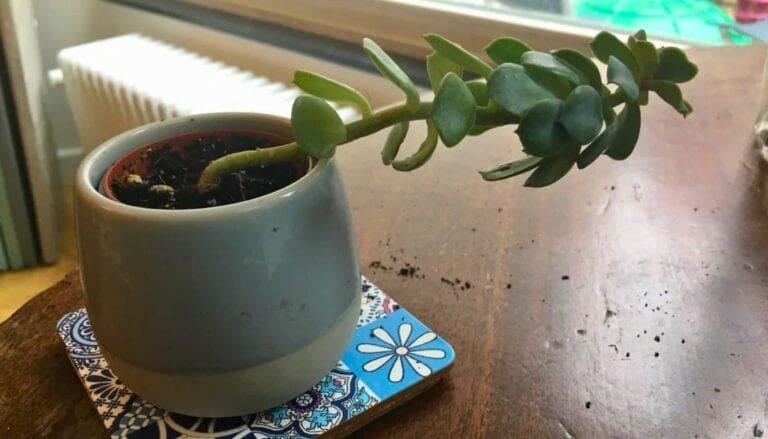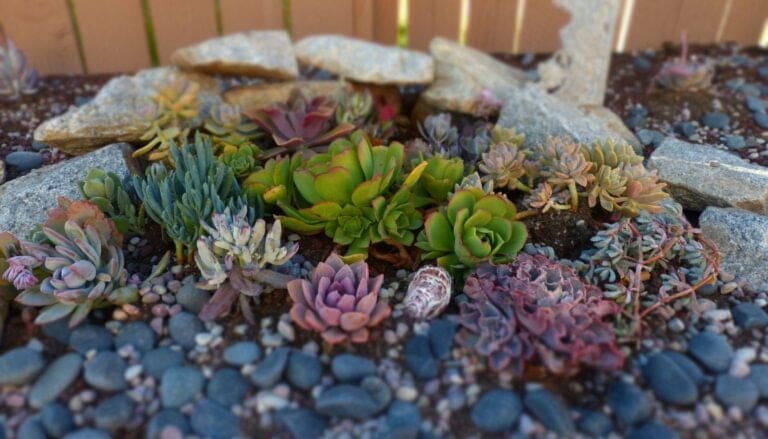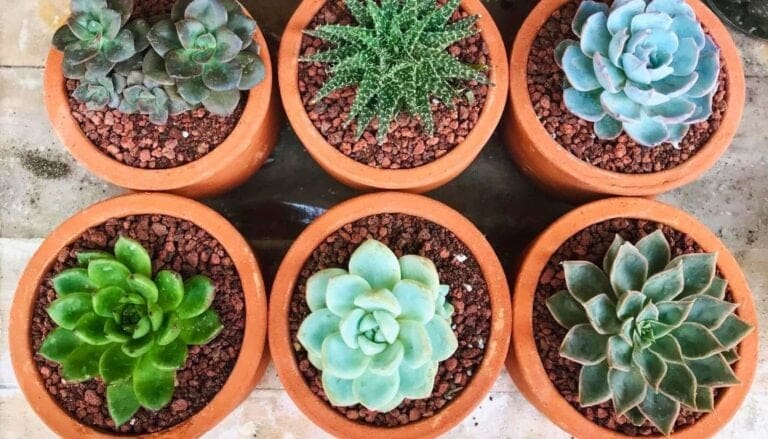7 Tips for Drainage Holes in Succulent Pots!
I love growing succulents! They’re such low-maintenance plants, but I’ve learned that having proper drainage in their pots is super important.
Without the right drainage, your succulents might not thrive.
So, I’m excited to share some helpful tips on making sure your plant pots are just right.
Have you ever had trouble with overwatered succulents? 🌵 I’ve been there.
Lucky for us, it doesn’t have to be difficult to fix.
In this article, we’ll explore how to set up your pots to keep those pretty plants happy and healthy!
Let’s get started! 😊

Please note: Simplify Plants is reader-supported. As an Amazon Associate, I earn from qualifying purchases made by our readers with no extra cost added to you all! Some links in the post are affiliate links and I get a commission from purchases made through links in the post.
1) Ensure proper drainage with terracotta pots
Have you ever had a succulent just give up on you?
It’s a common problem, and often the villain is poor drainage. 😟
No one wants that, right?
Terracotta pots are amazing for providing the drainage your succulents need.
These clay pots have a unique ability to absorb moisture from the soil, which helps prevent overwatering.
This means your plant roots stay nice and dry, exactly how they like it! 🌵
One cool thing about using terracotta is its natural look.
It fits beautifully with the rustic charm many of us love in our gardens or homes.
Have you tried decorating them? A splash of paint or some patterns can make them pop even more! 🎨
Now, here’s a question: Have you tried the classic “sound test”?
When shopping for a terracotta pot, give it a little tap.
If it makes a nice, solid sound, it should be good for drainage.
If not, it might not be as porous, which means less effective at keeping your plants happy. 🔊
Did you know? Terracotta pots come with drainage holes already drilled in!
This is a lifesaver for anyone like me who isn’t so handy with a drill.
No extra work required—a win-win!
Just make sure to place a saucer underneath to catch excess water.
If you have any terracotta pots lying around, now’s the perfect time to put them to use.
Your succulents will love you for it, and you’ll get to enjoy those lovely plants longer. 🌞
Let’s keep those succulents thriving together!
2) Use mesh tape to cover drainage holes
Ever wonder why your succulents look less happy after a while?
It might be because water isn’t draining well. 🌱
I once struggled with this issue myself.
Then, I found out about mesh tape, and it changed everything.
When I used it to cover the drainage holes in my pots, my plants perked up!
The mesh tape keeps the soil from slipping through the holes while still letting water escape.
This means happy roots and no mess at the bottom of the pot.
Applying mesh tape is super easy.
Just cut a small piece and place it over the hole before adding soil.
It’s simple and makes a world of difference.
Have you tried mesh tape for your pots yet? 😉
3) Consider using a pot with multiple drainage holes

I’ve got a little secret to share when it comes to keeping my succulents healthy.
Multiple drainage holes in a pot can make all the difference! 🌿
One drainage hole is good, but why settle for just one when you can have more?
Think of it as extra insurance.
If one hole gets clogged with soil or roots, the others are there to back it up.
I’ve found that using pots with several holes keeps water flowing out smoothly, reducing the risk of soggy soil.
Have you ever faced a surprise rainstorm and worried about puddles forming in your pots? I have!
Pots with multiple holes are better at draining excess water quickly.
This feature is a lifesaver for those surprise showers, allowing my plants to breathe easy.
Plus, they offer flexibility.
I can place these pots in trays or decorative outer containers without stress about water being trapped.
It’s like having a backup plan ready!
How do you deal with heavy rain? Let me know in the comments!
Picking pots with multiple drainage holes isn’t tricky either.
Many gardening stores, both online and offline, have them in different styles and colors.
So you don’t have to sacrifice style for function.
Remember, happier roots mean a healthier plant! 🌱
If you’re a fan of thriving succulents, give these pots a try.
Have you used these types before? Emoji your favorite succulent below!
4) Elevate pots with pot feet or stands
Sometimes, succulents need a little boost to stay happy.
Elevating pots with pot feet or stands is a great way to help with drainage.
When pots sit flat on a surface, water can get trapped.
This trapped water is not your succulent’s best friend. 🪴
By lifting the pots, I make sure that water flows out smoothly.
It helps keep the pot’s bottom dry and protects my lovely plants from root rot.
Plus, pot feet or stands can add a stylish look to my pot collection.
Who doesn’t love a fabulous plant setup? 🌿
I find that pot feet are often small and come in cute designs. They’re perfect for adding a fun touch to my plant area.
Stands often offer height and work great for larger pots. Do you have a favorite look?
Of course, I must check the stability. Nobody wants a tippy pot!
Picking sturdy stands or feet ensures my plants stay safe and sound.
Trust me, a little elevation can make all the difference in keeping succulents thriving.
Elevating also helps with air circulation around the pot.
This keeps things fresh for the roots and avoids unwanted moisture.
It’s like giving them a breath of fresh air. 🌬
Got some pots sitting directly on a shelf? Try elevating them! It might be just what they need. 🪴
What creative ways do you use to elevate your potted friends?
5) Mix Coarse Sand or Perlite into Soil

Mixing coarse sand or perlite into the soil is a game-changer for succulent lovers like me.
It helps the soil drain better, which is key for plants that hate sitting in water.
Plus, it makes the soil lighter, giving roots plenty of room to breathe. 🌵
Whenever I repot my succulents, I always add a bit of sand or perlite.
It’s like giving them a comfy new home.
You can find coarse sand at most garden stores, or if you prefer, perlite works just as well.
They both do wonders to keep the soil from getting too soggy.
I once forgot to do this, and my poor succulent paid the price.
Have you ever tried adding sand or perlite to your plants? It’s a simple step that really makes a difference.
Plus, it’s easy to mix—just combine it with potting soil, and you’re set!
Using these materials is also great because they don’t break down quickly.
That means less mess and upkeep for you.
I love spending time with my plants, but who wants extra work? 🌱
Roots need room to grow and search for water, so it’s nice to give them the best start possible.
If you’re not sure where to start, a 1:1 ratio of potting soil to sand or perlite is a good rule of thumb.
Experiment a bit and see what works for your plant babies!
Next time you’re potting succulents, remember these additions.
A little effort can lead to a thriving green corner in your home.
Trust me, your plants will thank you! 😊
6) Avoid using plates or saucers under pots
When I started growing succulents, I used to place plates or saucers under the pots. They seemed like a good idea to catch excess water.
But guess what? They often cause more harm than good. 🌿
Why, you ask?
Well, water can build up in the saucer, keeping the soil too wet. This is not ideal for succulents. They love dry conditions and really dislike sitting in water.
I remember a time when I lost a cute little aloe because I forgot to empty the saucer. It was a sad day! 😢
That’s when I learned that excess water can lead to root rot, which can be deadly for these plants.
Here’s a fun tip: instead of saucers, try using a plant stand to elevate your pot.
Doing this helps the water drain away properly. Also, it looks great and gives your plants a little lift! 🪴
Ever noticed how much happier plants look when they’re not waterlogged?
Next time, give the no saucer method a try. You’ll likely see your succulents thriving.
What do you think? Ready to ditch those saucers? 😊
7) Repurpose old coffee filters for drainage

I love finding new uses for things we usually throw away, like old coffee filters.
They’re perfect for drainage in succulent pots.
Placing a filter at the bottom of your pot lets water through while keeping the soil from washing out.
This trick keeps your plant’s roots happy and avoids a mess.
Plus, it gives an old coffee filter a second chance before heading to the trash.
Who knew a morning coffee could also help a garden grow? 🌱
Have you ever tried using coffee filters for other things? I bet they have more uses than we realize.
It’s fun to find creative ways to be more eco-friendly.
Tip: Reusing and repurposing helps both nature and your wallet.
So next time you finish brewing your coffee, remember that old filter and bring it to your plant area. Your succulents will thank you!
This little hack is a simple way to improve your plant care without spending extra money.
Have fun experimenting and see the difference it makes! 😊
Importance of Drainage Holes
Drainage holes in succulent pots are super important for keeping plants healthy.
They help prevent water from collecting at the bottom and keep the soil fresh and airy.
Nobody likes soggy roots or moldy dirt, right? Let’s dive into why these little holes are the heroes of plant care! 🌱
Prevents Root Rot
Ever notice how plants sometimes look great on top but have sad, sickly roots? That’s root rot for you!
Water sitting at the bottom of a pot can turn roots into mush. Drainage holes stop this by letting extra water escape.
It’s like a safety valve for your plant!
When roots are too wet, they can’t breathe. Yup, roots need air too. If they don’t get it, they decay and cause root rot.
Think of it this way: would you want to wear wet socks all day? Yeah, didn’t think so! 😅
Proper drainage means happier roots and healthier plants.
Enhances Soil Aeration
Drainage holes don’t just remove excess water; they also improve air flow.
When water drains out, air flows in.
This keeps the soil from getting too packed and lets roots breathe easy.
Think of it as aerating a lawn. Holes let more air get down to those roots.
This aeration is essential for keeping the soil fresh and preventing bad smells.
So, let’s hear it for drainage holes! They’re small, but mighty, in keeping our plant pals happy. 🌵✨
Choosing the Right Pots

Before planting succulents, picking the right pot is vital for their well-being.
The type of pot and material both play a big role in helping your plants thrive.
Let’s explore these key factors! 🌱
Types of Pots with Drainage Holes
Drainage holes help prevent water from building up, which could harm your succulents.
Terracotta and ceramic pots often come with these essential holes. They help keep your plant roots dry and happy.
Plastic pots can be tricky. While light and versatile, they might need extra holes drilled in.
How about hanging pots? They can save space, but remember to check for those drainage holes!
Without them, you might find your plants swimming—which isn’t their favorite activity! 🏊♂️
Have you tried using pots with removable saucers? They allow extra water to escape but can catch some in reserve just in case.
Material Considerations
Materials can affect temperature and moisture levels.
Terracotta is a breathable option, allowing water to evaporate slowly. It’s perfect for those who might over-water.
Ceramic pots often look stylish with glazed finishes. They lock in moisture, which is great for dry environments.
Watch out for metal—it heats up quickly in the sun!
If I ever use metal, I go for a shaded spot to avoid roasting my succulent friends.
Plastic pots are light and colorful, but they might not breathe well.
I love using them indoors where the sun isn’t too intense. ⚡
Are you keeping your pots inside or outside? It might change your choice of material!
Proper Placement of Succulent Pots
Finding the right spot for your succulent pots is key to keeping them healthy. Whether you’re placing them indoors or outdoors, the right location can make a big difference.
Also, using saucers or trays can help manage water drainage and protect surfaces.
Indoor vs Outdoor Placement
When deciding between indoor or outdoor spaces for succulents, think about sunlight and temperature changes.
Indoors, I place my succulents near a window where they can soak up enough indirect sunlight.
Bright, indirect light is usually best. 🌞 Too much direct sunlight might scorch the leaves.
Outside, I’ve found a shaded patio or a spot with morning sun works well.
Extreme temperatures or harsh weather can harm these little guys.
Do you have a spot that gets just the right amount of sun and shade? If so, your succulents will thrive there!
Using Saucers and Trays
I always use saucers or trays under my pots to catch excess water. This prevents messes, especially inside.
Plus, it stops water from pooling around the pot, which helps keep the roots from drowning.
When choosing a saucer, pick one that matches your pot’s size. Too small, and it overflows; too large, and it looks silly. You know what I mean? 😄
A good-fitting tray keeps your space tidy and protects furniture from water damage or stains.
Remember to empty the saucer regularly to prevent it from turning into a mini swamp!
Frequently Asked Questions
Let’s tackle some common questions about growing succulents in pots with or without drainage holes. We’ll cover essential topics like how to water them, what materials are ideal for drainage, and how often watering should happen. 🌵
Do succulents need drainage holes in their pots?
Absolutely! Drainage holes help prevent water from collecting at the bottom. If water stays there, it can harm your succulent’s roots.
Without these holes, it’s a bit like giving someone soggy shoes every day—nobody likes that!
How can I water my succulents if my pot doesn’t have a drainage hole?
No hole? No problem! Just water more carefully.
Try giving small amounts so the soil is moist but not soggy.
Picture how you’d sprinkle water on a delicate plant rather than pouring too much.
What are the best practices for watering succulents from the bottom?
When watering from the bottom, place the pot in a shallow tray of water.
The soil will soak up the water like a sponge. Leave it there for about 10-15 minutes, then remove it to let any excess water drain.
Should I water my succulents from the top or the bottom to promote healthy growth?
Both methods can work if done right.
Top watering is fine as long as you avoid wetting the leaves too much.
Bottom watering is great for early morning. It’s like asking if you prefer waffles or pancakes—both can be tasty! 🥞
What materials work best at the bottom of pots to enhance drainage for succulents?
Using materials like coarse sand, gravel, or perlite helps water flow out easily.
Imagine them acting like a superhero cape for your succulent, protecting it from the evil, lurking water.
How frequently should I be watering my succulents to maintain proper moisture?
Once a week is usually plenty, but this can depend on the climate.
Imagine if you wore sweatpants on a hot day versus winter!
Check if the soil is dry before adding more water, like testing if spaghetti’s soft enough. 🍝
Recommended Garden Supplies
| Product Image | Our Recommended Gardening Supplies | Check Offers! |
|---|---|---|
Top Top
Top
Top
Top
Top
Top
Top
Top | rePotme Houseplant and Tropical Classic Potting Soil Mix | Check Offer On Amazon |
 Top
Top
Top
Top
Top
Top
Top
Top | Espoma Organic Indoor Plant Food | Check Offer On Amazon |
 Top
Top
Top
Top
Top
Top
Top
Top | GooingTop LED Grow Light 6000K Full Spectrum Clip Plant Growing Lamp | Check Offer On Amazon |
 Top
Top
Top
Top
Top
Top
Top
Top | Soil Moisture Meter | Check Offer On Amazon |
 Top
Top
Top
Top
Top
Top
Top
Top | Govee Hygrometer Thermometer, Bluetooth Enabled! | Check Offer On Amazon |
 Top
Top | LEVOIT Humidifiers for Large Room(Best For Plants) | Check Offer On Amazon |
 Top
Top
Top
Top
Top
Top
Top
Top | Upgraded DIY Automatic Drip Irrigation Kit, 15 Potted Houseplants Support | Check Offer On Amazon |
 Top
Top
Top
Top
Top
Top
Top
Top | Stainless Steel Heavy Duty Gardening Tool Set | Check Offer On Amazon |
 Top
Top
Top
Top
Top
Top
Top
Top | Bonide Insecticidal Soap | Check Offer On Amazon |
 Top
Top
Top
Top
Top
Top
Top
Top | Bonide 32 oz Spray Neem Oil for Organic Gardening | Check Offer On Amazon |
 Top
Top
Top
Top
Top
Top
Top
Top | Garden Safe Fungicide | Check Offer On Amazon |







